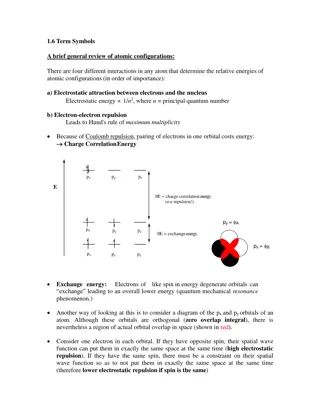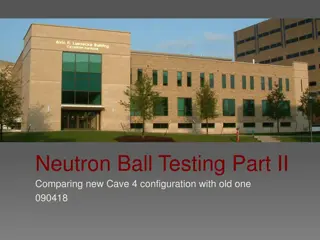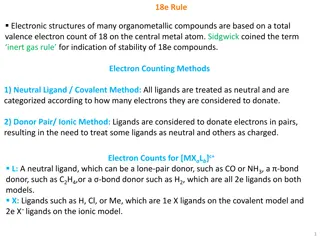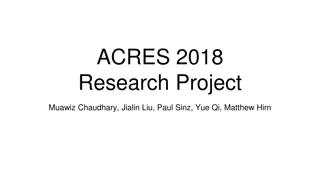Types of groups and reactions
This information discusses electron-donating groups (EDGs) and electron-withdrawing groups (EWGs), their effects on molecule reactivity, examples of each group, nucleophiles, and electrophiles. EDGs increase electron density, making nucleophiles stronger, while EWGs decrease electron density, making
0 views • 14 slides
Understanding Lewis Symbols in Chemistry
Lewis symbols are used to describe electron configurations in atoms and molecules. They help in understanding how elements form bonds by sharing or transferring electrons. The Octet Rule guides the formation of compounds, but exceptions exist. Double and triple bonds show atoms sharing multiple elec
0 views • 10 slides
Understanding Atomic Configurations and Term Symbols
The energy of atomic configurations is determined by electrostatic attraction between electrons and the nucleus, electron-electron repulsion, spin-orbit coupling, and spin-spin interactions. Term symbols in electronic spectroscopy specify atomic states using quantum numbers. Hund's rule and the Paul
8 views • 12 slides
Understanding Ionic and Metallic Bonding: Valence Electrons, Octet Rule, and Ion Formation
Explore the essential concepts of ionic and metallic bonding, focusing on valence electrons, electron dot structures, the octet rule, cations, anions, and ion formation. Discover how atoms achieve stability through electron transfer, and learn to write electron configurations for various ions.
9 views • 52 slides
Advanced Techniques in Materials Science: Transmission Electron Microscopy
Explore the advanced techniques used in materials science, focusing on Transmission Electron Microscopy (TEM). Learn about the challenges with optical microscopes, the principles of TEM imaging, and the application of scattering theory in electron microscopy. Discover how TEM offers higher resolutio
3 views • 19 slides
Understanding Ionic and Metallic Bonding in Chemistry
Explore the concepts of ionic and metallic bonding in chemistry through discussions on valence electrons, electron dot structures, the octet rule, cations, anions, and more. Dive into the world of ions and electron configurations to understand how atoms achieve stability through the gain or loss of
3 views • 62 slides
Understanding Chemical Bonds and Ionic Compounds
Ionic bonds are formed when atoms transfer electrons to achieve stable electron configurations, resulting in the creation of ions with positive or negative charges. Metals are good conductors due to their ability to easily lose electrons. The charges of ions depend on the number of valence electrons
0 views • 49 slides
Understanding Ionic and Metallic Bonding in Chemistry
Explore the concepts of ions, electron dot structures, the octet rule, cations, and anions in Chapter 7. Learn how elements achieve stability through electron configurations, and practice writing electron dot structures and naming ions. Understand the differences between cations and anions and how t
1 views • 52 slides
Advanced Microbunched Electron Cooling for EIC Design Overview
Microbunched electron cooling is a cutting-edge technique proposed for the Electron-Ion Collider (EIC) design, aimed at enhancing beam properties through coherent electron interactions. The concept utilizes Coherent Electron Cooling (CeC) and broad-band amplification in the form of Micro-bunched Ele
1 views • 16 slides
Understanding Electron Configurations and Atom Properties
Explore topics including electron configuration, full shells, atomic numbers, and properties of elements like Ytterbium, Bromine, Mercury, Magnesium, and Europium. Learn about isotopes, ions, and orbital electron distribution in atoms like Europium and Nitrogen, as well as practice completing electr
1 views • 10 slides
Understanding Cathode Ray Tubes (CRT) in Oscilloscopes
Cathode Ray Tubes (CRTs) are key components in oscilloscopes, modulating and accelerating electron beams to create images of electrical waveforms, radar targets, and more. Unlike TVs, CRTs in oscilloscopes use electrostatic deflection for precise beam control. The electron gun assembly consists of a
0 views • 18 slides
Exploring the Free Electron and Nearly Free Electron Models in Solid State Physics
The Free Electron Model postulates that electrons in metals move freely without interacting with crystal ions, yielding insights on conductivities. Developed by Arnold Sommerfeld, it combines the Drude model with quantum mechanics. Conversely, the Nearly Free Electron Model leans on quantum mechanic
0 views • 22 slides
Discussion on Multi-PUSCH Configuration for UTO-UCI Content Moderator at Ericsson
This discussion encompasses the configuration and implications of the Multi-PUSCH setup based on agreed parameters within the UTO-UCI content moderation context at Ericsson. It delves into varying configurations, potential impacts, and considerations for effective utilization. The slides provide ins
0 views • 17 slides
Electronic Meeting Agenda: UE PC2 for NR Inter-Band CA and SUL Configurations
The document relates to the upcoming electronic meeting of 3GPP TSG-RAN WG4, focusing on UE power class 2 for NR inter-band Carrier Aggregation and supplemental uplink configurations. It includes background contributions, identified issues, and options for SAR schemes addressing duty cycle based sol
5 views • 5 slides
Understanding the 18-Electron Rule in Transition Metal Organometallic Compounds
The 18-electron rule governs the stability of transition metal organometallic compounds by requiring the sum of metal d electrons and ligand-supplied electrons to be 18. This rule highlights the importance of electron count and ligand characteristics in forming stable complexes. Key concepts include
0 views • 15 slides
Configurations and Tests Overview in Integrated Applications
This content provides an overview of various configurations and tests in integrated applications, covering aspects such as status, loaded configurations, readiness checks, server tests for HV and LV systems, as well as client-server interactions. It details the different components involved and thei
0 views • 5 slides
Accelerator Technology R&D Targets and Sources Overview
The SnowMass2021 Accelerator Frontier AF7 focuses on Accelerator Technology R&D, exploring targets and sources such as high brightness electron sources, muon sources, and high intensity ion sources. The community planning meeting discussed various Letter of Interest submissions outlining innovative
0 views • 7 slides
Understanding Quantum Numbers and Electron Configurations in Chemistry
Explore the quantum numbers for electrons in subshells, learn about electron configurations and filling rules, and grasp the concepts of orbital energy levels in chemistry. Discover the Aufbau Principle, Pauli Exclusion Principle, and Hund's Rule through engaging activities and worksheets.
1 views • 18 slides
Understanding Electron Correlation and Basis Sets in Molecular Calculations
Polarized basis sets describe the electron density polarization in atoms and molecules to improve accuracy in computed geometries and frequencies. Diffuse basis sets are recommended for calculating electron and proton affinities. Electron correlations account for electron interactions in molecular c
0 views • 8 slides
Understanding Electron-Phonon Interactions in Iron-Based Superconductors
This discussion explores the effects of electron-phonon interactions on orbital fluctuations in iron-based superconductors. Topics covered include ab initio downfolding for electron-phonon coupled systems, evaluation methods such as Constrained Random Phase Approximation (cRPA), Constrained Density-
0 views • 12 slides
Understanding Microwave Tubes and Klystron Technology
Microwave tubes play a crucial role in high-frequency applications due to their efficiency and operating principles. Conventional tubes face limitations beyond 100MHz, while efficient microwave tubes utilize electron velocity modulation for power conversion. Klystron tubes, such as Reflex Klystron,
4 views • 19 slides
Comparison of New and Old Cave Configurations in Neutron Ball Testing
This content discusses the comparison between the new and old cave configurations in the Neutron Ball testing part II. It showcases images and descriptions of the different cave configurations, highlighting the progress in research at the Cyclotron Institute. The Neutron Ball's functionality and tes
0 views • 14 slides
Ion Beam Intensity Enhancement Through Electron Heating in Collider Experiments
The study discusses electron heating of ions in collider experiments at the Collider V. ParkhomchukBINP facility in Novosibirsk. It explores the effects of electron cooling on ion beams, ion beam oscillations, losses, and ion beam intensity enhancement. Various factors such as ion charge, classical
0 views • 9 slides
Understanding the 18e Rule in Organometallic Compounds
The 18e rule dictates the electronic structures of many organometallic compounds, emphasizing a total valence electron count of 18 on the central metal atom for stability. Electron counting methods like the Covalent and Ionic models assist in determining the electron distribution among ligands. The
0 views • 8 slides
Understanding Electron Configurations and the Periodic Table in Chemistry
Explore the world of electron configurations in atoms, subshells, and electron arrangement using the periodic table. Learn about the organization of electrons in subshells, different ways to represent electron arrangements, and how to determine electron configurations based on the periodic table. Di
0 views • 12 slides
Nonstationary Configurations of a Spherically Symmetric Scalar Field
Action and stress-energy tensor, Einstein-Klein-Gordon equations, and method for constructing nonstationary configurations of a spherically symmetric scalar field are discussed in this study. The behavior of the characteristic function allows interpretations such as black holes, wormholes, or naked
0 views • 14 slides
Overview of Magnet Configurations at GSI Helmholtzzentrum GmbH
This document provides detailed information on the magnet configurations at GSI Helmholtzzentrum GmbH, focusing on multiplet designs, magnetic field simulations, quadrupoles, sextupoles, and steering dipoles. It covers the general design of SC multiplets, requirements on axis and angles, and specifi
2 views • 17 slides
Understanding VSEPR Theory for Molecular Geometry
VSEPR theory explains how the arrangement of electron groups around a central atom determines the shape of molecules based on the repulsions between different types of electron groups. The geometry of a molecule is influenced by factors such as lone pairs, single, double, or triple bonds, and their
0 views • 16 slides
Understanding Electronic Configurations Through Simplified Assignments
Exploring electron configurations and orbital regions using simplified notations colored in on Periodic Charts. Descriptions and visual aids for Carbon, Fluorine, and excited state of Fluorine. Learn to assign s, p, d, and f electron neighborhoods without memorization through a fun song. Includes te
0 views • 14 slides
Understanding Microscopes: Light vs. Electron Microscopes
Learn about the differences between light microscopes (LM) and electron microscopes (EM), including their magnification power, resolving power, and key parts. Explore the types of electron microscopes such as Transmission Electron Microscope (TEM) and Scanning Electron Microscope (SEM) for advanced
0 views • 8 slides
Understanding Electron Microscopy: A Comprehensive Overview
Electron microscopy (EM) is a powerful technique used in biomedical research to visualize detailed structures of various specimens at high resolution. The process involves an electron gun, electromagnetic lenses, specimen holder, and imaging systems. There are two main types of electron microscopes:
0 views • 12 slides
Understanding Interfacial Defects and Microscopy in Materials Science
Interfacial defects are boundaries separating regions with different crystal structures, like grain boundaries in polycrystalline materials. Microscopic examination distinguishes between macroscopic and microscopic dimensions, analyzed through optical and electron microscopy methods. Electron micros
0 views • 9 slides
Understanding Scanning Electron Microscopes (SEM) and Electron Sources
Scanning Electron Microscopes (SEMs) utilize focused electron beams to produce high-resolution images by interacting with a sample's electrons. The electron source, such as the electron gun, plays a crucial role in forming fine electron beams for imaging purposes. Different types of electron sources
0 views • 12 slides
Quantum Interactions: Electrons, Phonons, and Hubbard Interaction
Exploring the complexities of electron-electron and electron-phonon interactions, nonequilibrium Green's functions, Hartree-Fock method, Coulomb's law, quantum operator forms, Hubbard interaction, and electron-phonon interactions from first principles. The interactions delve into the behavior of cha
0 views • 20 slides
Design of a 10 MeV Beamline for E-beam Irradiation at UITF Wastewater Facility
This paper discusses the design of a 10 MeV beamline at the Upgraded Injector Test Facility for electron beam irradiation, focusing on wastewater treatment for environmental restoration. The use of electron beam irradiation is highlighted as an effective method to remove pollutants like 1,4 dioxane
0 views • 9 slides
Advancements in Machine Learning for Electron Density Prediction
Electron density is crucial for understanding atomic bonding. This research project explores using machine learning, specifically a Unet architecture, to predict electron density in a Lithium-Oxygen-Lithium system. The data set was generated by varying the positions of Lithium atoms and calculating
0 views • 8 slides
Advancing Electron Microscopy in Life Sciences through UEM Feasibility Demonstration
Demonstration project of the feasibility of a sub-nanometer, picosecond electron microscope for life sciences applications. The goal is to image biological cells with resolution below 200nm using a proof-of-concept system integrated with existing UED setup. The project builds on previous successes i
0 views • 14 slides
DC Motor Control Techniques and Configurations
This chapter delves into various aspects of PWM and DC motor control, exploring characteristics of selected DC motors, rotation mechanisms, H-bridge configurations for motor direction control, logic configurations for motor operation, bidirectional motor control using an L298 chip, pulse width modul
0 views • 27 slides
Fundamentals of Electron Beam Ion Sources for Ionization: A Comprehensive Overview
Delve into the intricacies of Electron Beam Ion Sources (EBIS) and Electron Beam Ion Traps (EBIT) with a focus on their historical development, key operating principles, and main concepts. Explore the production of high charge states for accelerator applications, electron beam confinement, ionizatio
0 views • 10 slides
Understanding Microbial Physiology: The Electron-NADP Reduction Pathway
Dr. P. N. Jadhav presents the process where electrons ultimately reduce NADP+ through the enzyme ferredoxin-NADP+ reductase (FNR) in microbial physiology. This four-electron process involves oxidation of water, electron passage through a Q-cycle, generation of a transmembrane proton gradient, and AT
0 views • 29 slides







































